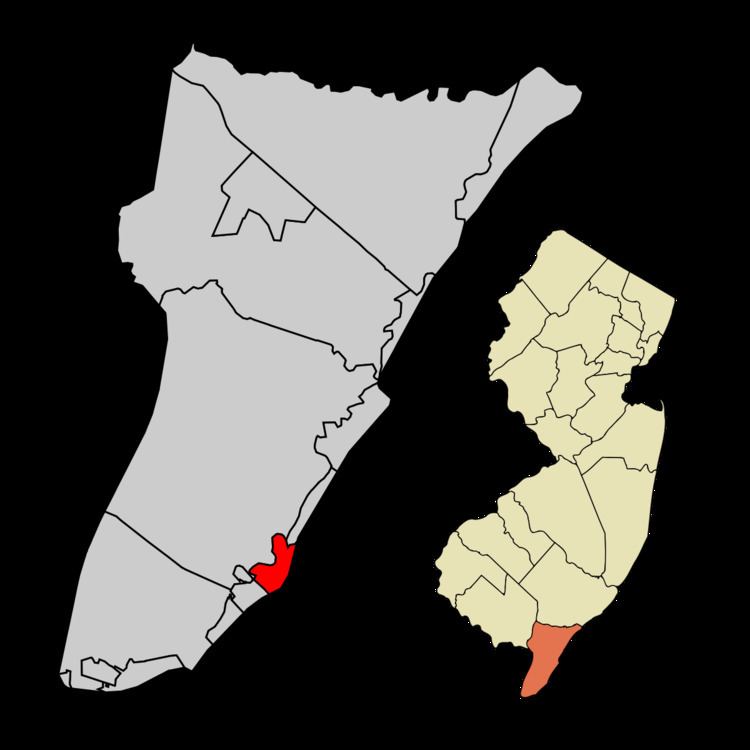 | ||
The North Wildwood Beach Patrol is a department under the supervision of the Public Safety Committee of City Council in the City of North Wildwood, New Jersey, responsible for the oversight, supervision, and regulation of beach patrons. It is responsible for the supervision of approximately 1.5 miles of public beaches, servicing hundreds of thousands of bathers every summer. Lifeguards are certified in ocean rescue, land rescue, police assistance, and first aid and medical assistance, including CPR. Beach Patrol Chief Tony Cavalier has been with the Patrol for more than 40 years.
Contents
- Beach Patrol History
- Lifeguard Qualifications
- Equipment
- Daily Routine
- Beschen Callahan Memorial Lifeguard Races
- The Around the Island Row
- References
North Wildwood is located on the southern tip of New Jersey. North Wildwood, along with the City of Wildwood and the Borough of Wildwood Crest, make up a five-mile-long island that is separated from the mainland of New Jersey by bays and marshland ( ). The three municipalities together make up the world’s single largest free, public beach. North Wildwood, Wildwood and Wildwood Crest are independent municipalities with separate governments and public works; however, they often assist each in times of need and trouble.
Beach Patrol History
North Wildwood Beach Patrol was originated in 1914 by Mayor Harry Hoffman due to the rising need for beach safety and supervision. The patrol, when it first began, was a small collection of men in charge of overseeing the safety and well-being of the beach patrons, and it wasn’t until seventy-two years later in 1986 that the first women qualified and were hired by the beach patrol( ) .
Lifeguard Qualifications
Lifeguards need to be athletic, healthy, strong individuals to patrol the beach. Swimming in a rough ocean is difficult enough alone, but to have to support and swim in struggling patrons is very difficult and cannot be done by everyone. Lifeguards must successfully pass a set of rigorous tests to ensure that they will be capable of enduring rescues and ocean swimming. The tests include but are not limited to: running a mile in under 7:30 minutes, swimming 500 meters in under 10 minutes, swimming a mile in the ocean over the course of the summer, a timed surf dash, a timed ocean swim and run, and a personal interview. Other tests must be passed during “rookie school” to be hired by the beach patrol and to be declared on active duty. After acceptance by the beach and commencing working, lifeguards do not have the ability to slack off and stop working out; they must participate in mandatory workouts to uphold extreme fitness.
Equipment
Uniforms and equipment of a North Wildwood lifeguard have changed dramatically. When the beach patrol was originated in 1914, the uniform was a one-piece tank suit made of wool, which did not dry when it was wet, and the buoy the lifeguard carried was a diamond-shaped tin can attached to a rope.
As years passed, the uniform was divided into individual pieces, but still remained wool, and the buoy was upgraded to fiberglass and rubber. Eventually in the early 1980s, the buoy was replaced by the torpedo, which was made of plastic and had a sleeker, torpedo-like shape. Also, as the years progressed, the uniform became mesh and nylon, which was lighter and dried faster than wool. In the early days of the beach patrol, the buoy was all the lifeguard had to rescue a swimmer. Today, the beach patrol has jet-skis, row boats, and long surfboards, called paddleboards that can be used to help rescue swimmers in rough waters, in life and death situations, or multiple victims at once.
Daily Routine
The typical six-day work week schedule of a North Wildwood Beach Patrol Lifeguard is as follows:
After morning workouts, lifeguards then sit up on the lifeguard stand and ready themselves for a long day. During the day, lifeguards are not permitted to take breaks, or use the restroom; the only time it is acceptable to get off of the stand is to enter the water to swim amongst the patrons or to go onto a rescue.
Beschen-Callahan Memorial Lifeguard Races
The Beschen-Callahan's is the lifeguard race that is sponsored and operated by the North Wildwood Beach Patrol. The races were created in 1969 to honor two lifeguards who gave their lives fighting in the Vietnam War, James Beschen and Michael Callahan. More than 1,000 spectators come to watch the Beschen-Callahans every year, along with all lifeguard races, and the races have gained enough popularity to be televised on ESPN and other sports networks ( ).
The Around the Island Row
Rowing is a very large aspect of lifeguarding, in rescues and in competition. Those beach patrol with strong rowers have better rescue abilities. The Around the Island Row is a race, ran by the North Wildwood Beach Patrol, which enables pairs of rowers to represent their respective beach patrols in a grueling, long distance, endurance-based rowing race. The course is 22.5 miles in length and it travels around the 5 mile island. The boats begin out in the ocean and follow the coast line around through the inlet, and into the back bays, where they must navigate around islands and shallow areas, before heading through another inlet and back into the ocean, where it is a straight shot to the finish line.
